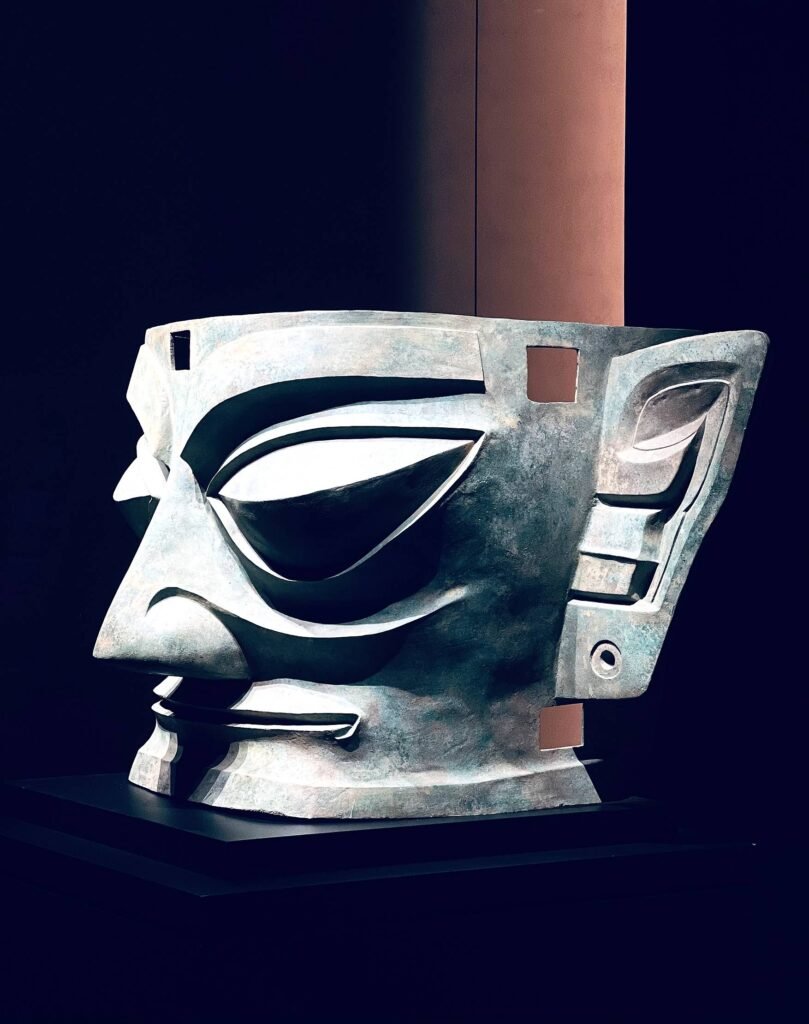The Faces of Sanxingdui, a civilization that was not even recorded in “Records of the Grand Historian” , broke out of the ground carrying a matrix of artifacts that did not belong to any known dynasty – a 2.8-meter-high bronze sacred tree tore through the strata, the fish and bird patterns on the golden scepter glowed coldly under the searchlight, and the pair of bronze eyeballs on the vertical-eyed mask, with 16 centimeters protruding from the eye sockets, were staring at the trembling instruments of the modern archaeological team.

Even more bizarre is the sacrificial pit: three tons of ivory were arranged to form an accurate star map, five hundred years earlier than the Twenty-Eight Mansions system; and the traces of jade cutting showed a craftsmanship that was a thousand years ahead of its time.
There are no words, no bones, only the unearthed jade fragments with a crystallized layer similar to laser burning. When the carbon-14 detector in the exploration area began to count down, the archaeological team members present suddenly realized that perhaps it was not us who discovered Sanxingdui, but Sanxingdui chose this era. Why did this civilization that mastered astronomy, smelting, and mathematics collectively destroy all traces during its heyday?
The Sanxingdui site is located in Guanghan, Sichuan Province, China, and is about 4,000 years old. The unearthed cultural relics are famous for their unique shapes and exquisite craftsmanship, including bronze masks, large bronze standing figures, bronze sacred trees, golden staffs, jade artifacts, etc.

Since 2021, more than 15,000 numbered cultural relics have been unearthed from the six newly discovered sacrificial pits , including more than 4,800 relatively complete artifacts , including more than 1,000 bronze artifacts , more than 600 ivory tusks , more than 500 gold artifacts og more than 500 jade artifacts . In addition, more than 4,000 remains related to the production and processing of jade and stone artifacts were discovered in other areas of the Sanxingdui site from 2022 to 2024. At present , the number of cultural relics unearthed at the Sanxingdui site exceeds 20,000.
.
This makes us wonder what the strange “vertical eye” mask of Sanxingdui The Faces represents.
The bronze vertical-eyed mask was unearthed in the No. 2 sacrificial pit of the Sanxingdui site in 1986, dating back more than 3,800 years. It is one of the “six national treasures” unearthed from the Sanxingdui site.
The mask is square, with inverted eight-shaped knife-shaped eyebrows, the tip of the eyebrows is raised, the eyes are slanted, and the eyeballs are extremely exaggerated, protruding outward in a columnar shape of 16 cm; the ear tips are in the shape of peach points; the nose is hooked, the corners of the mouth are deep and long, and the tip of the tongue is slightly exposed, as if smiling mysteriously; the lower jaw is protruding forward; there is a square hole in the middle of the forehead.
The eyes are protruding outward in a columnar shape. A pair of ears with carved patterns are fully spread out on both sides, with a magnificent shape and majestic appearance. It is the earliest and largest bronze mask in the world.

What secrets does this special-shaped artifact hide? Why does it appear in this shape?
These questions have always puzzled the entire archaeological community, and everyone has different guesses about it.
1. Origin of
Cancong When the jade silkworm from Sanxingdui No. 3 sacrificial pit emerged, all archaeologists held their breath. This jade silkworm, only 3.8 cm long but engraved with mysterious symbols, may be the key to unlocking the legend recorded in the “Huayang Guozhi Shuzhi” written by Chang Qu of the Jin Dynasty: “There was a Shu Hou Cancong, whose eyes were vertical and he was the first to be called king. ” In the mist of the bronze sacred tree and the golden scepter, the ancestor of the ancient Shu who had been forgotten for 4,000 years is
slowly emerging from the fault zone between mythology and archaeology .

Legend has it that in the 14th year of King Jie of Xia, King Jie sent General Bian to attack Cancong and Youmin . So Cancong told Youmin that he could use beautiful women to make King Jie lose the mood for war. Sure enough, after being bewitched by the beauties, King Jie announced that he would return to the court.
Cancong was revered in the hearts of the ancient Shu people. He taught the people to raise silkworms and reel silk, which opened up the agricultural civilization of ancient Shu. He was regarded as the founder and patron saint of ancient Shu civilization. The ancient Shu people cast Cancong’s image into masks and used them in important rituals such as sacrifices. This was not only a remembrance and admiration for the former king, but also a hope to use Cancong’s divine power to bless the ancient Shu land with good weather, peace and prosperity.
The Records of the Kings of Shu records that Cancong “dressed in blue and taught the people how to raise silkworms and sericulture.” The carbon-14 test of silk residues unearthed from the Sanxingdui site shows that their age precisely corresponds to the period of Cancong’s rule .

Some other scholars believe the opposite. According to the Mianzhu Chronicle, Cancong became king around the time of King Xiang of the Eastern Zhou Dynasty (around 652 BC). After that, there were the Shu kings Bai Guan, Yu Fu, Du Yu, Kai Ming, etc., until it was destroyed by the Qin State in 316 BC. During this period, the ancient Shu Dynasty lasted for about 336 years.
However, this timeline does not completely match the age of Sanxingdui civilization (approximately 1800 BC – 1200 BC), and there is a lack of direct evidence to prove the relationship between Cancong and the Eastern Zhou Dynasty.
The Faces of Sanxingdui Is there anything else you want to know?

